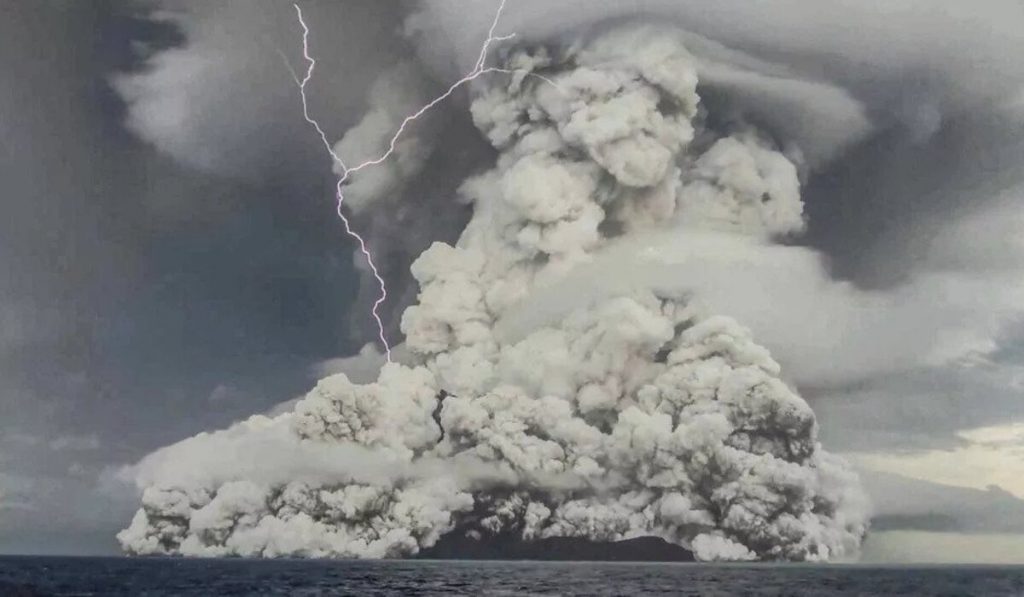In a groundbreaking study recently published in the journal Geophysical Research Letters, researchers have unveiled the astonishing findings from the eruption of the Hunga Tonga-Hunga Ha’apai volcano in 2022. This underwater volcano, located off the coast of the Kingdom of Tonga in the South Pacific, unleashed a cataclysmic event that defied all expectations, producing an unprecedented display of natural fury.
According to NASA, the eruption surpassed all records in terms of its explosive force, overshadowing the power of 100 simultaneous Hiroshima bombs. Magma erupted from the depths of the volcano, instantly vaporizing the surrounding seawater.
The result was a colossal mushroom cloud, composed of ash, gas, and an astonishing 50 million tons (45 million metric tons) of water vapor, surging into the sky.
The new study reveals that these extraordinary conditions within the volcanic plume triggered an astonishing phenomenon—a supercharged thunderstorm of unparalleled magnitude.
Alexa Van Eaton, the lead author of the study and a renowned volcanologist at the U.S. Geological Survey (USGS), described this event as “a supercharged thunderstorm, the likes of which we’ve never seen before.”
The collision of electrically charged particles within the plume, including ash, supercooled water, and hailstones, led to a mesmerizing spectacle of lightning. The researchers estimate that over 192,000 lightning flashes, comprising nearly 500,000 electrical pulses, illuminated the sky during the peak of the storm.
To put this into perspective, the lightning storm reached a staggering intensity of 2,615 flashes per minute. Astonishingly, some of the lightning bolts soared to unprecedented heights of up to 19 miles (30 kilometers) above sea level, marking the highest measurements ever recorded.
“With this eruption, we discovered that volcanic plumes can create the conditions for lightning far beyond the realm of meteorological thunderstorms we’ve previously observed,” Van Eaton said. “It turns out, volcanic eruptions can create more extreme lightning than any other kind of storm on Earth.” That includes lightning from supercell storms and tropical cyclones, according to the study.
To analyze this groundbreaking event, scientists meticulously compiled data from multiple sources, including the Geostationary Lightning Mapper, a NASA tool specifically designed to track lightning activity from space.
“It wasn’t just the lightning intensity that drew us in,” Van Eaton said. “The scale of these lightning rings blew our minds. We’ve never seen anything like that before; there’s nothing comparable in meteorological storms. Single lightning rings have been observed, but not multiples, and they’re tiny by comparison.”
As the volcanic plume expanded in a gravity wave pattern, similar to a mushroom, the lightning mirrored this expansion, rippling out in concentric rings that oscillated and contracted.
Beyond the mesmerizing display, the study also shed light on the eruption’s duration. Contrary to initial projections of only lasting an hour or two, the plumes generated by the Hunga Tonga-Hunga Ha’apai eruption persisted for an astounding minimum of 11 hours.
This new understanding of volcanic eruptions, paired with the tracking of lightning intensity, could revolutionize eruption monitoring and greatly enhance our ability to issue timely warnings related to volcanic risks.
The findings of this study signify a major step forward in comprehending the tremendous power unleashed by volcanic eruptions. As scientists delve deeper into the complex interplay between volcanic activity and atmospheric conditions, our understanding of these natural phenomena expands, providing invaluable insights into the Earth’s geological processes.
“These findings demonstrate a new tool we have to monitor volcanoes at the speed of light and help the USGS’s role to inform ash hazard advisories to aircraft,” Van Eaton said.

